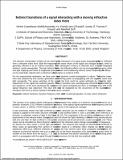Files in this item
Indirect transitions of a signal interacting with a moving refractive index front
Item metadata
| dc.contributor.author | Munoz, Michel Castellanos | |
| dc.contributor.author | Petrov, Alexander Yu | |
| dc.contributor.author | O'Faolain, Liam | |
| dc.contributor.author | Li, Juntao | |
| dc.contributor.author | Krauss, Thomas F. | |
| dc.contributor.author | Eich, Manfred | |
| dc.contributor.editor | Subramania, GS | |
| dc.contributor.editor | Foteinopoulou, S | |
| dc.date.accessioned | 2015-03-03T12:31:01Z | |
| dc.date.available | 2015-03-03T12:31:01Z | |
| dc.date.issued | 2014 | |
| dc.identifier | 172281434 | |
| dc.identifier | b782d168-4dcc-4662-9e5f-cfad8396ab2d | |
| dc.identifier | 000344105600022 | |
| dc.identifier | 84922647515 | |
| dc.identifier | 000344105600022 | |
| dc.identifier.citation | Munoz , M C , Petrov , A Y , O'Faolain , L , Li , J , Krauss , T F & Eich , M 2014 , Indirect transitions of a signal interacting with a moving refractive index front . in GS Subramania & S Foteinopoulou (eds) , Active Photonic Materials VI . vol. 9162 , Proceedings of SPIE , vol. 9162 , SPIE , Bellingham , Conference on Active Photonic Materials VI , San Diego , United States , 17/08/14 . https://doi.org/10.1117/12.2063078 | en |
| dc.identifier.citation | conference | en |
| dc.identifier.issn | 0277-786X | |
| dc.identifier.uri | https://hdl.handle.net/10023/6159 | |
| dc.description | This research was supported by the German Research Foundation DFG (EI 391/12-2). | en |
| dc.description.abstract | The dynamic manipulation of light can be achieved by the interaction of a signal pulse propagating through or reflected from a refractive index front. Both the frequency and the wave vector of the signal are changed in this case, which is generally referred to as an indirect transition. We have developed a theory to describe such transitions in integrated photonic crystal waveguides. Through indirect transitions, the following effects can be envisaged: large frequency shifts and light stopping and order of magnitude pulse compression and broadening without center frequency shift. All effects can be potentially realized with a refractive index modulation as small as 0.001. For the experimental realization, we have used slow light photonic crystal waveguides in silicon. The refractive index front was obtained by free carriers generation with a switching pulse co-propagating with the signal in the same slow light waveguide. The group velocities of the signal and the front could be varied arbitrarily by choosing the right frequencies of the signal and switching pulses. The indirect transition was unambiguously demonstrated by considering two situations: a) the front overtaking the signal and b) the signal overtaking the front. In both cases, a blue shift of the signal frequency was observed. This blue shift can only be explained by the occurrence of the expected indirect transition and not by a direct transition without wave vector variation. | |
| dc.format.extent | 6 | |
| dc.format.extent | 437700 | |
| dc.language.iso | eng | |
| dc.publisher | SPIE | |
| dc.relation.ispartof | Active Photonic Materials VI | en |
| dc.relation.ispartofseries | Proceedings of SPIE | en |
| dc.subject | Indirect transition | en |
| dc.subject | Dynamic frequency shift | en |
| dc.subject | Photonic crystal waveguides | en |
| dc.subject | On-chip | en |
| dc.subject | Silicon photonics | en |
| dc.subject | Crystal wave-guides | en |
| dc.subject | Electromagnetic-waves | en |
| dc.subject | Ionization front | en |
| dc.subject | Conversion | en |
| dc.subject | Silicon | en |
| dc.subject | Light | en |
| dc.subject | QC Physics | en |
| dc.subject.lcc | QC | en |
| dc.title | Indirect transitions of a signal interacting with a moving refractive index front | en |
| dc.type | Conference item | en |
| dc.contributor.institution | University of St Andrews. School of Physics and Astronomy | en |
| dc.contributor.institution | University of St Andrews. Microphotonics and Photonic Crystals Group | en |
| dc.identifier.doi | 10.1117/12.2063078 |
This item appears in the following Collection(s)
Items in the St Andrews Research Repository are protected by copyright, with all rights reserved, unless otherwise indicated.

